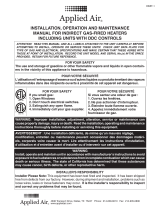
SERIES 61 AND SERIES 62 MODUTROL IV™ MOTORS
5 63-2629EF—01
Feedback Potentiometer (Series 62 Models Only):
TRADELINE Models (Can be shunted for slaving a
Series 90 Motor).
Approvals:
Underwriters Laboratories Inc. Listed: File No. E4436, Guide
No. XAPX. For USA and Canada.
U.S. Patents: pending
Accessories:
220736A Internal Auxiliary Switch Kit; one switch, can be
field-installed.
220736B Internal Auxiliary Switch Kit; two switches, can be
field-installed.
220738A Adapter Bracket raises motor shaft height by 3/4
inch (19 mm) to match that of previous Modutrol Motor
models.
220741A Screw Terminal Adapter converts the standard
quick-connect terminals to screw terminals.
221455A Infinitely Adjustable Crank Arm, can rotate through
downward position and clear motor base without requiring
an adapter bracket.
4074ERU Weatherproofing Kit provides NEMA 3 rating for
Modutrol IV Motors mounted in position other than upright.
50017460-001 Internal Transformer; 24/120/230 Vac 50/60 Hz
primary, 24 Vac secondary, quick connect terminals.
50017460-003 Internal Transformer; 120 Vac 50/60 Hz pri-
mary, 24 Vac secondary, quick connect terminals.
7617ADW Crank Arm, can rotate through downward position
and clear motor base without requiring an adapter bracket.
Q100 Linkage connects Modutrol Motor to V51 Butterfly
Valve. Requires the 220738A Adapter Bracket.
Q181 Auxiliary Potentiometer for sequence or unison control
of 1 to 4 additional modulating (Series 90) motors.
Q5001 Bracket and Linkage Assembly connects Modutrol IV
Motor to water or steam valve.
Q605 Damper Linkage connects motor to damper. Includes
motor crank arm.
Q607 External Auxiliary Switch controls auxiliary equipment
as a function of motor position.
ES650-117 Explosion-Proof Housing encloses motor for use
in explosive atmospheres. Not for use with Q5001 (or any
other valve linkages). Order separately from Nelson Enclo-
sures. To order, contact:
EGS Enclosures in Houston, TX
Karen Barfield 281-774-3763
http://appletonelec.com
Part number ES-650-117
You need to order a 7617DM coupling assembly from
Honeywell to use with the cover.
INSTALLATION
When Installing this Product...
1. Read these instructions carefully. Failure to follow them
could damage the product or cause a hazardous
condition.
2. Check the ratings given in the instructions and on the
product to make sure the product is suitable for your
application.
3. Installer must be a trained, experienced service
technician.
4. After installation is complete, check out product
operation as provided in these instructions.
Electrical Shock or Equipment Damage Hazard.
Can shock individuals or short equipment
circuitry.
Disconnect all power supplies before installation.
Motors with auxiliary switches can have more than one
disconnect.
Equipment Damage Hazard.
Can damage the motor beyond repair.
Never turn the motor shaft by hand or with a wrench.
Forcibly turning the motor shaft damages the gear
train and stroke limit contacts.
IMPORTANT
Always conduct a thorough checkout when
installation is complete.
Location
Allow enough clearance for accessory installation and motor
servicing when selecting a location (see Fig. 2). If located
outdoors, use liquid-tight conduit connectors with the junction
box to provide NEMA 3 weather protection. If mounted
outdoors in a position other than upright, install a 4074ERU
Weatherproofing Kit and liquid-tight connectors to provide
NEMA 3 protection.
Motor Damage Hazard.
Deteriorating vapors and acid fumes can damage
metal parts.
Install motor in areas free of acid fumes and other
deteriorating vapors.
In excessive salt environments, mounting base and screws
should be zinc or cadmium plated, not stainless steel or brass.
Use the 220738A Adapter Bracket for mounting on these
surfaces.
Mounting
Use the following guidelines for proper motor mounting:
• Always install motors with the crankshaft horizontal.
• Mounting flanges extending from motor housing base are
drilled for 1/4 inch (6.4 mm) machine screws or bolts.
• Non-Spring Return Motors are shipped from the factory in
the closed position (at the limit of counterclockwise
rotation, as viewed from the power end of the motor).
Adapter Bracket
The 220738A Adapter Bracket, positioned between the motor
and the equipment, raises motor shaft height by 0.75 in.
(19 mm) to match that of previous Modutrol Motor models.
The following applications require this bracket:
• Q607 External Auxiliary Switch.
• Damper linkage applications require added clearance to
allow:





















